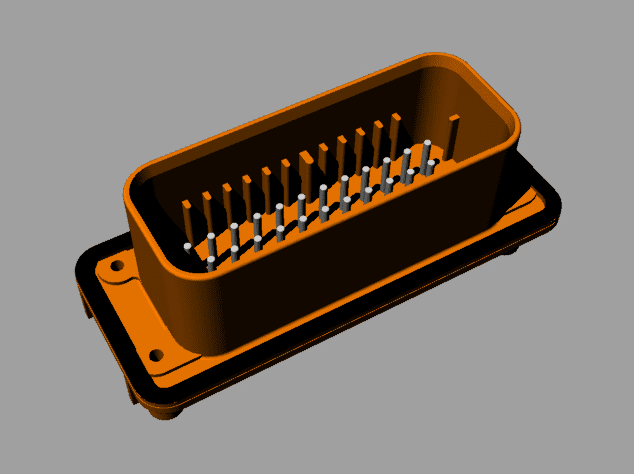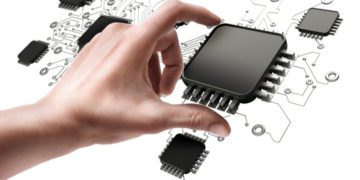
3D view of a new board requires STEP models for CAD libraries
Folding phones, robots, wearables, and medical devices… these products and many more carry strict mechanical requirements that must be met if a new device will enter the market. Your ECAD and MCAD tools play a big role in meeting the mechanical requirements of your new product, but your tools become meaningless without the right 3D STEP models for CAD libraries.
STEP models are an extremely useful neutral file format that provides a bridge between ECAD and MCAD applications. These files conform to the ISO 10303 standards, but they do not contain CAD vendor-specific information. Instead, STEP models for CAD libraries allow your design team to be adaptable and reuse data in multiple CAD applications. They can also be imported directly into popular MCAD applications for enclosure design and mechanical modeling. If you’re designing advanced products with strict mechanical requirements, then you need STEP models in your CAD libraries. Not all distributors will give you STEP models for components, but you can find verified models from the right parts aggregator.
Why You Need STEP Models for CAD Libraries
Your ECAD application contains a number of useful tools, such as symbol and footprint creators, a library generator, and even a 3D viewer. The STEP models in your CAD libraries form the cornerstone of your 3D viewer; you won’t have an accurate 3D view of your board or its mechanical behavior if your STEP files are inaccurate. Similarly, you won’t be able to create an accurate enclosure for your board if you lack the right STEP files for your electronic components.
If you have a PCB CAD tool, chances are high that you’re able to generate 3D models for common parts with standard packaging. 3D models for SMD passives and ICs with IPC-compliant pin arrangements can be easily generated using high-quality PCB design applications, and these models will have highly accurate dimensions.
For other, less-common components, you’ll need to build or find accurate 3D models for components before you can focus on the mechanical aspects of your new product. Your component data will be accessible in MCAD and ECAD applications once you add STEP models for your components.

3D model for a wire-to-device connector. This common electronic component has specific mechanical features that need to be included in STEP models for CAD libraries.
PCB designers that need a 3D view of their board need accurate STEP models for electronic components. However, mechanical components also need their own STEP models as part of enclosure design and mechanical modeling. Some examples include module sizes for sensors, brackets, connectors, screws and bolts, and the enclosure itself.
From ECAD to MCAD with STEP Models
When you’re designing a complex enclosure in an MCAD application, you’ll need to create a STEP model for your entire board. This is then imported into your MCAD application and the enclosure can be designed around the board. Reputable ECAD applications will allow you to export a 3D STEP model for the board and import it into other mechanical design platforms. Your ECAD application will take the information from your component STEP files and the board itself, and it will create a new STEP file that includes all the 3D structural information for your board in a single file.
The best ECAD platforms won’t require you to create and export this intermediate STEP file. Instead, you can open the MCAD tool alongside the ECAD application as a plugin, which then recreates the structure of your board directly from your design data. The tools access all the required 3D structural information directly from STEP models in your CAD libraries and build the 3D view of your board and components. Keeping updated STEP models in your electronic component libraries is a huge time saver when it comes to mechanical design.
Finding the Right STEP Models for CAD Libraries
Of course, getting the mechanical portion of any design correct requires finding the right STEP files. No designer wants to do a complete redesign simply because they couldn’t see the correct clearances in a 3D model. If you have access to the right 3D CAD models for your components, then you can design a mechanically accurate enclosure for your new product.
The best ECAD programs provide search features for finding components, but many library files only contain the schematic symbol and footprint, and they omit a STEP file. Some distributors provide 3D models for components on their websites, but only for extremely popular components (e.g., SMD resistors and capacitors). As an example, you might have a difficult time finding STEP models for many mechanical components such as connectors and heatsinks. Unless the manufacturer or distributor provides 3D models, you’ll be left with the following options to find components:
- Create 3D models from datasheets: You’ll need to create a model for the component in an MCAD application and export it as a STEP file. Sometimes, you may be able to adapt an existing 3D model to a new component.
- Find models on a community forum: Sites like GrabCAD allow users to upload 3D models for mechanical and electronic components, where they are shared with other users. Be careful with this as there’s no guarantee these models have the correct dimensions.
- Use a parts aggregator or search engine: Aggregators and search engines provide access to a repository of components provided by multiple manufacturers and distributors. Some of these are subscription services and others rely on community contributions. The best parts aggregators get their models directly from manufacturers.
Not all designers have enough CAM/MCAD experience to execute the first option successfully or in a short amount of time. The second option above is also undesirable due to risks that component models are incorrect. In contrast, the third option above is the best option as you’ll have some confidence these models are correct. The best parts services work directly with component manufacturers to obtain verified component models. This type of service saves you time and reduces your risk of redesigns.
When you use a service like Ultra Librarian, you’ll have immediate access to verified 3D models for your components and all at no cost to you. Keeping track of STEP models for CAD libraries is easy and you’ll be able to immediately use these through popular ECAD applications. You’ll also have access to sourcing information from worldwide distributors. All the components provided by Ultra Librarian are provided directly from manufacturers, which reduces your design time and risk.
Acquiring STEP models and manually creating design libraries takes most teams dedicated resources and time, Ultra Librarian helps by making this process redundant. Working with Ultra Librarian sets up your team for success to ensure any design is going through production and validation with accurate models and footprints to work from. Register for free today.








